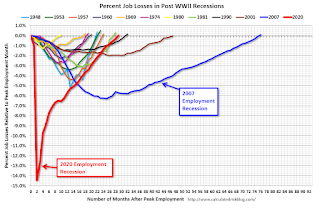Total nonfarm payroll employment rose by 528,000 in July, and the unemployment rate edged down to 3.5 percent, the U.S. Bureau of Labor Statistics reported today. Job growth was widespread, led by gains in leisure and hospitality, professional and business services, and health care. Both total nonfarm employment and the unemployment rate have returned to their February 2020 pre-pandemic levels.
…
The change in total nonfarm payroll employment for May was revised up by 2,000, from +384,000 to +386,000, and the change for June was revised up by 26,000, from +372,000 to +398,000. With these revisions, employment in May and June combined is 28,000 higher than previously reported.
emphasis added

The first graph shows the job losses from the start of the employment recession, in percentage terms.
The current employment recession was by far the worst recession since WWII in percentage terms.

In July, the year-over-year change was 6.15 million jobs. This was up significantly year-over-year.
Total payrolls increased by 528 thousand in July. Private payrolls increased by 471 thousand, and public payrolls increased 57 thousand.
Payrolls for May and June were revised up 28 thousand, combined.
The third graph shows the employment population ratio and the participation rate.

The Employment-Population ratio increased to 60.0% from 59.9% (blue line).

The unemployment rate was decreased in July to 3.5% from 3.6% in June.
This was well above consensus expectations; and May and June payrolls were revised up by 28,000 combined.